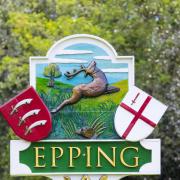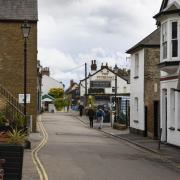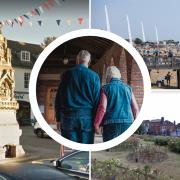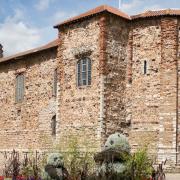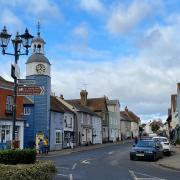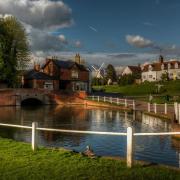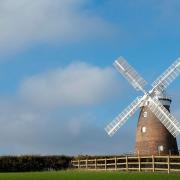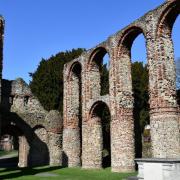Essex is densely packed with wildlife: from nature and bird reserves to reservoirs and woodlands, we have picked some amazing wildlife spots in Essex

Abberton Reservoir
The huge expanse of Essex & Suffolk Water’s Abberton Reservoir, south of Colchester, is one of Europe’s top wetland sites. Internationally important as a haven for ducks, swans and other water birds, its proximity to the sea coast ensures that it also attracts all-manner of migratory birds.
The road across the reservoir at Layer Breton Causeway provides superb views of nesting cormorant and grey heron and, in winter, close-up views of smew and, with patience, bittern.
Essex Wildlife Trust’s nearby nature reserve has a number of bird hides overlooking the water and in late summer you may be lucky enough to see an osprey fishing. Or, enjoy a drink and a snack from the trust’s visitor centre, which boasts superb panoramic views over the reservoir, which itself, following last year’s completion of the water company’s expansion project, has varied water levels and vegetation at the fringes, making the site even better for wildlife.
Search: www.essexwt.org.uk/reserves/abberton-reservoir

Langdon
The Langdon Hills, just a few miles from Basildon, make a mockery of the notion that Essex is flat. With wonderful views into London and stunning walks up and down, through woodland and meadows and past lakes and orchards, this is a lovely area at any time of year, but is especially good in high summer for wild flowers, including orchids, and butterflies. Species recorded include white admiral, green hairstreak, marbled white and grizzled skipper.
Search: www.thurrock.gov.uk/langdon-hills-country-park

Fingringhoe Wick
This beautiful site, perched on a bluff above the Colne Estuary southeast of Colchester, was the first nature reserve opened by Essex Wildlife Trust (1961). A mosaic of habitats – river, tidal marsh, freshwater lake, reedbed, grassland, scrub, woodland and more – in close proximity ensure that Fingringhoe is home to diverse species like few other nature reserves in the country.
The jewel in Fingringhoe’s crown is the nightingale and dozens of males sing here in unison each spring. In winter, thousands of ducks, waders and brent geese arrive, while birds of prey patrol the skies. Fingringhoe is also an excellent site for reptiles (especially adder), wild flowers and butterflies.
There is a visitor centre, several bird hides and, later this summer, a new wetland, created in partnership with the Environment Agency, will open to public view.
Search: www.essexwt.org.uk/reserves/fingringhoe-wick

Tollesbury Wick
Essex Wildlife Trust’s 600-acre site on the Blackwater Estuary is a rare example of an Essex freshwater grazing marsh, worked for decades by traditional methods sympathetic to wildlife. Recent conservation work to augment wet areas of the reserve has had spectacular results in winter, with thousands of lapwing and golden plover present, while in spring there are increasing numbers of breeding waders, including redshank.
The reserve, which includes a bird hide, is a short walk from Tollesbury Marina. A longer, bracing walk around the seawall is rewarded with spectacular views of the estuary and Mersea Island.
Other excellent sites on the Blackwater Estuary include the RSPB’s Old Hall Marshes, the National Trust’s Copt Hall and Essex Wildlife Trust’s Abbotts Hall Farm.
Search: www.essexwt.org.uk/reserves/tollesbury-wick

Blue House Farm
Essex Wildlife Trust’s fabulous reserve on the north bank of the Crouch Estuary is a great site to see two of our county’s most magical species: barn owl and brown hare.
In winter, hundreds of brent geese are joined by thousands of wigeon, while in summer, breeding birds usually include avocet, sometimes fabulously close to the hides.
Elsewhere on the Crouch Estuary is the RSPB’s large-scale Wallasea Island project, while a boat trip from Burnham on Crouch is a fantastic way to see the Crouch and the Roach estuaries. Look for common seals hauled out on the mudflats and osprey on migration.
Search: www.essexwt.org.uk/reserves/blue-house-farm

Hanningfield Reservoir
Essex & Suffolk Water’s reservoir, near Billericay, is a great site to see numerous species of duck while, in summer, thousands of swallows, martins and swifts congregate to feed over the water.
Essex Wildlife Trust has a nature reserve, including bird hides, along part of the reservoir. The reserve’s woodlands are home to woodpeckers, tits and finches while the roof of the trust’s visitor centre is home to a remarkable maternity roost of hundreds of pipistrelle bats. Join the trust at summer events to see the bats emerge at dusk.
Search: www.essexwt.org.uk/reserves/hanningfield-reservoir

The Naze & Hamford Water
The Naze, just north of Walton, is a unique coastal landscape of outstanding geological and biological importance. As the most easterly peninsula in Essex, it is an important site for migrating birds. Many rare species are recorded each year, especially in early autumn, and it boasts a number of different habitats, both terrestrial and marine. Look for common and grey seals in the sea and channels, plus waders, terns and gulls on the marshes. To the west of the Naze is the marvel that is Hamford Water – the inspiration for Arthur Ransome’s Secret Water. Essex Wildlife Trust is due to open a new centre at the Naze this summer.
Search: www.essexwt.org.uk/reserves/naze

Thameside Nature Park
Opened by Sir David Attenborough three years ago, this remarkable park has been developed atop a former landfill site, right next to the Thames Estuary. There are internationally important numbers of waders, dozens of skylarks singing over the grasslands, brown hare, shrill carder bee, reptiles and orchids.
Essex Wildlife Trust’s dramatic visitor centre has sensational views over the river, especially from its roof terrace, from where you can watch ships, as well as birds. Very occasionally, even a porpoise is spotted too.

Ancient Woodlands
Our county’s ancient woodlands are a joy to savour in their own right, but these oaks, hornbeams, hazels and more support wonderfully diverse wildlife. In south Essex, nature reserves such as Essex Wildlife Trust’s Pound Wood in Daws Heath boast stunning displays of bluebells in spring. More elusive is the rare heath fritillary butterfly and the adorable dormouse. Why not visit the trust’s Belfairs Woodland Centre, a partnership project with Southend-on-Sea Borough Council, to learn more about these wonderful woods?
At the other end of the county, close to the border with Cambridgeshire, ancient woodland is of crucial importance to the oxlip and other woodland flowers, while orchids, woodpeckers and nuthatches can also be seen. Essex Wildlife Trust’s West Wood near Thaxted and Shadwell Wood near Saffron Walden are good examples and lovely places for a walk at any time of year.
And the list goes on…
In a feature such as this, it is only possible to scratch the surface as there are so many other sites worthy of mention. Essex is a county of incredibly diverse habitats and therefore wonderfully rich wildlife. Particularly noteworthy are Epping and Hatfield forests in the west and, across the county, Cudmore Grove on Mersea Island and Colne Point on Tendring are both spectacular.
While our majestic estuaries catch the eye of people and wildlife, the inland waterways are home to otter, kingfisher, water vole and more. The Stort Navigation, on the border with Hertfordshire south of Bishop’s Stortford, is a lovely stretch, as is the River Roding as it meanders into London. While close to the capital, Essex can still lay claim to the Ingrebourne River Valley and its wonderful birdlife, while RSPB Rainham Marshes is just downstream.
There are two sites on opposite sides of Tendring which are always worth a visit: Holland Haven and Wrabness. Further south, Two Tree Island is a superb coastal site on the Thames at Leigh on Sea. Beyond Southend lies Gunners Park in Shoeburyness. This park is an outstanding site for migratory birds, such as warblers, pipits and flycatchers, as it is the first landfall as they arrive at the mouth of the Thames.
On a warm summer’s evening, the county’s commons and heathland can also be utterly entrancing. Try Danbury Common east of Chelmsford or Tiptree Heath, where you may be lucky enough to watch hobbys hunting insects. It’s a far cry from the vast expanse of Abberton Reservoir or the grazing marshes and mudflats of Tollesbury Wick, but actually little more than five miles from either. It just goes to show how wonderfully varied a county we live in.
Find out more
For full details of all Essex Wildlife Trust nature reserves and visitor centres, including access, directions and, where applicable, opening times, go to www.essexwt.org.uk/visitor-centres-nature-reserves.




